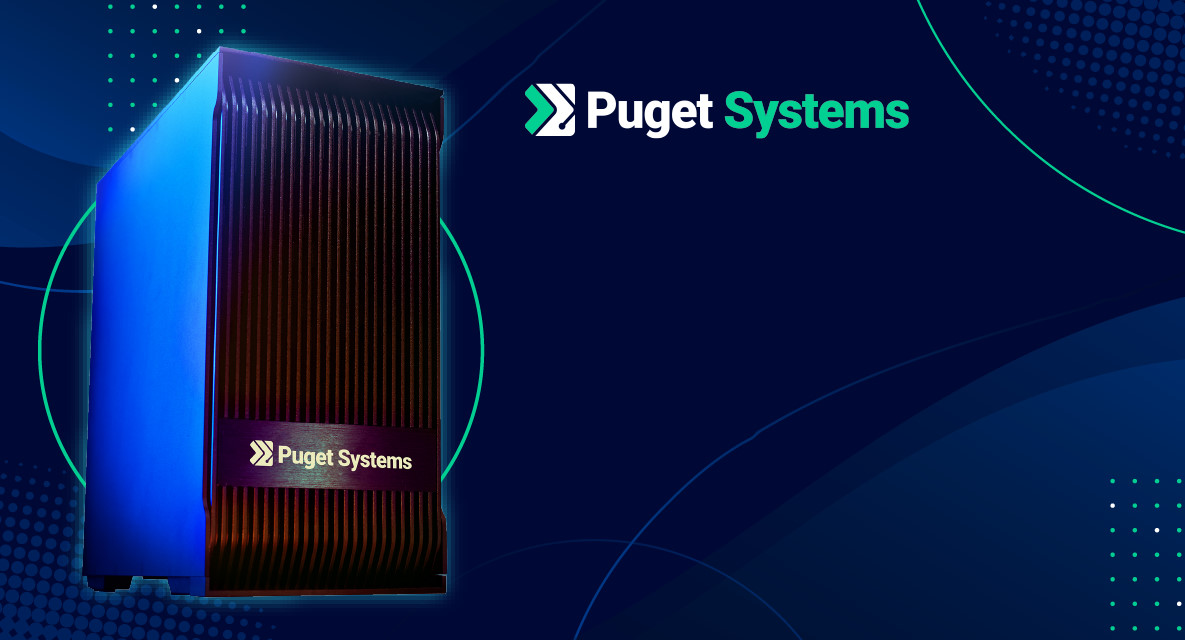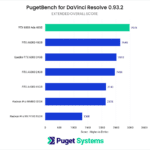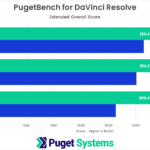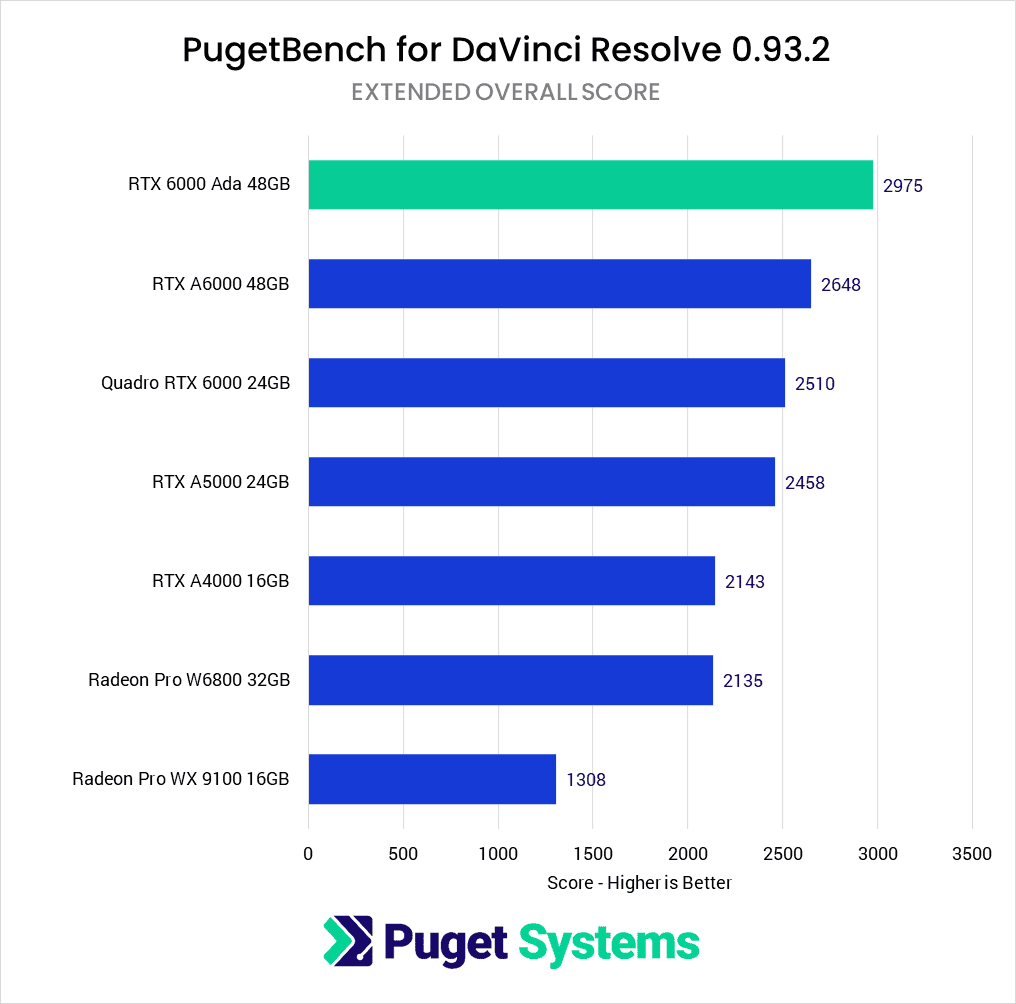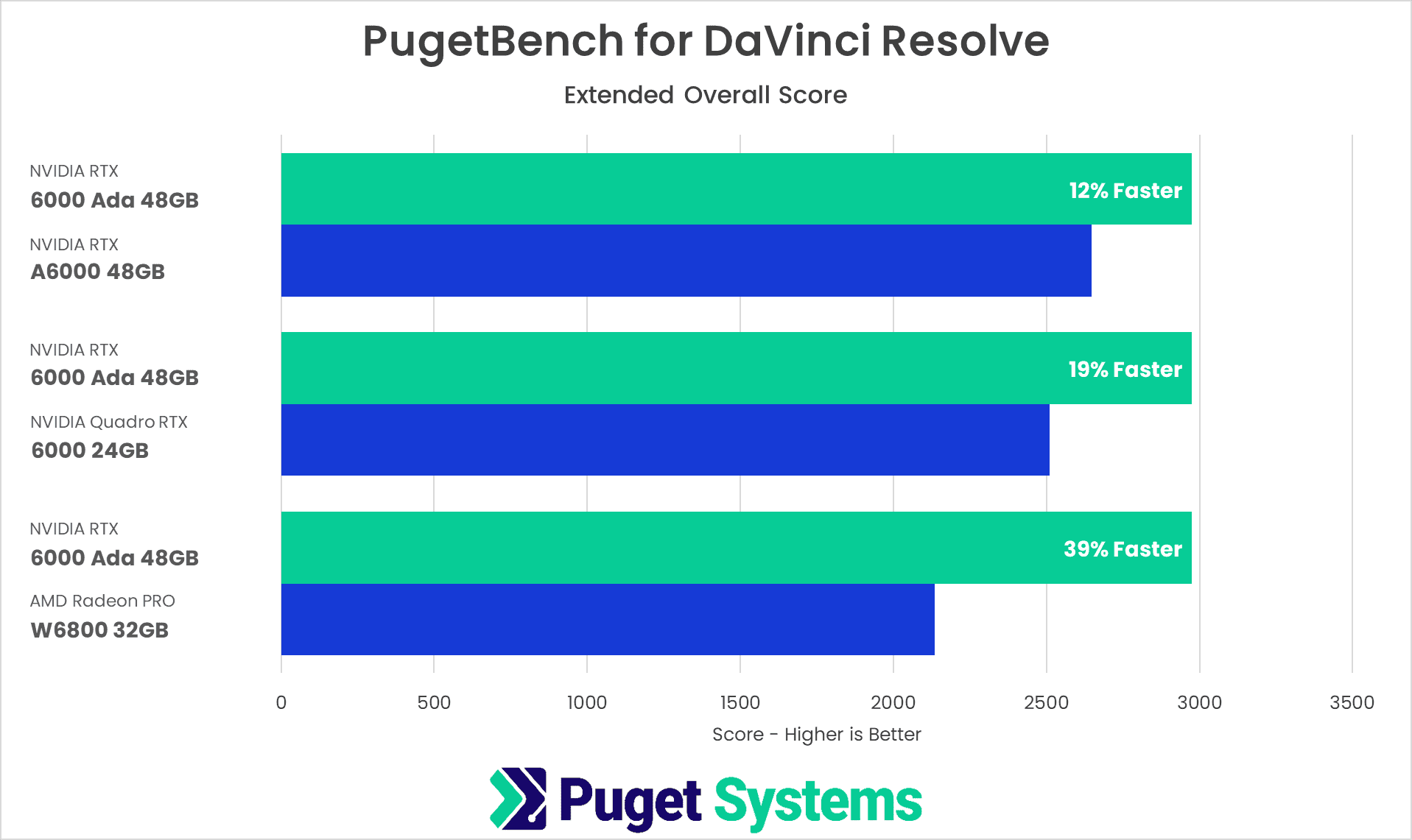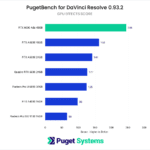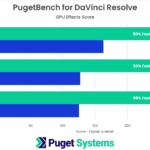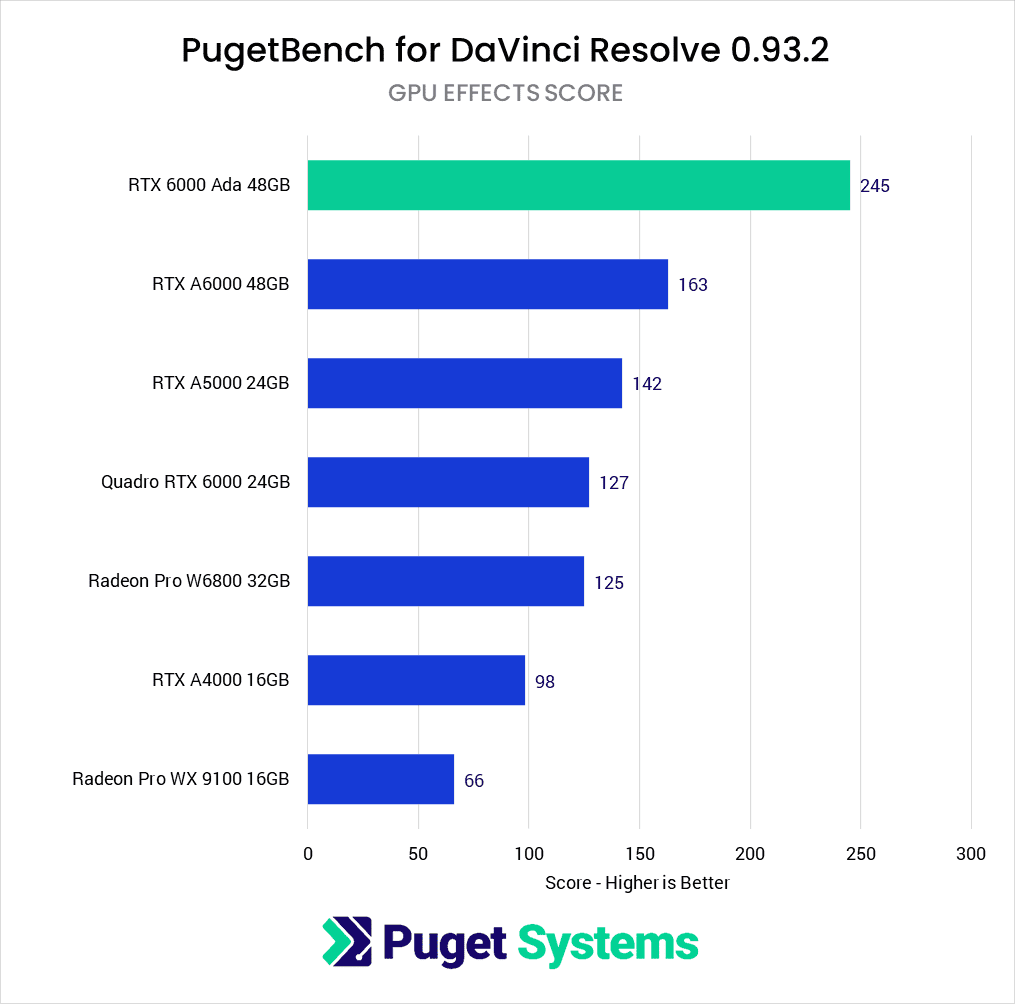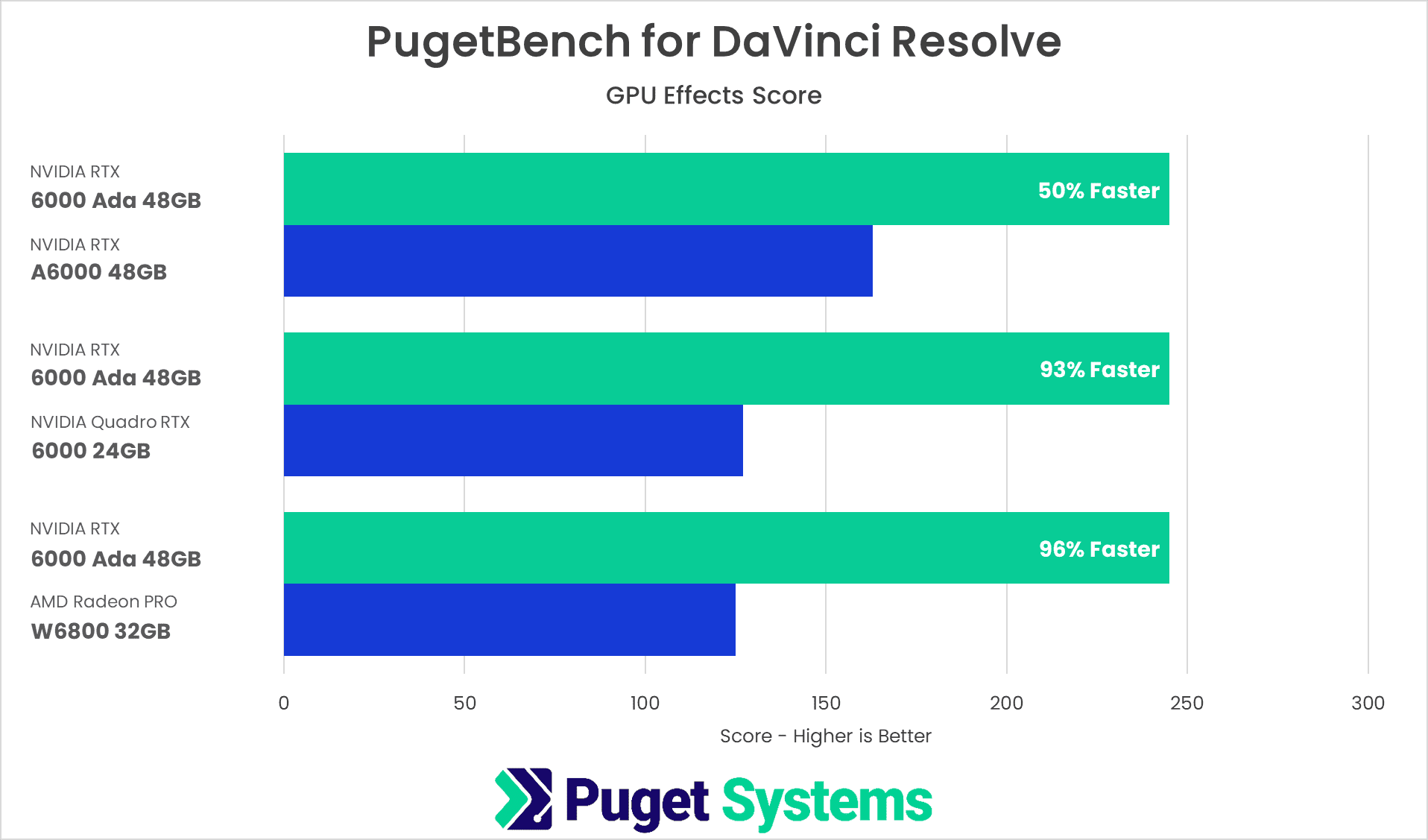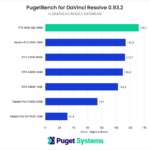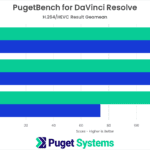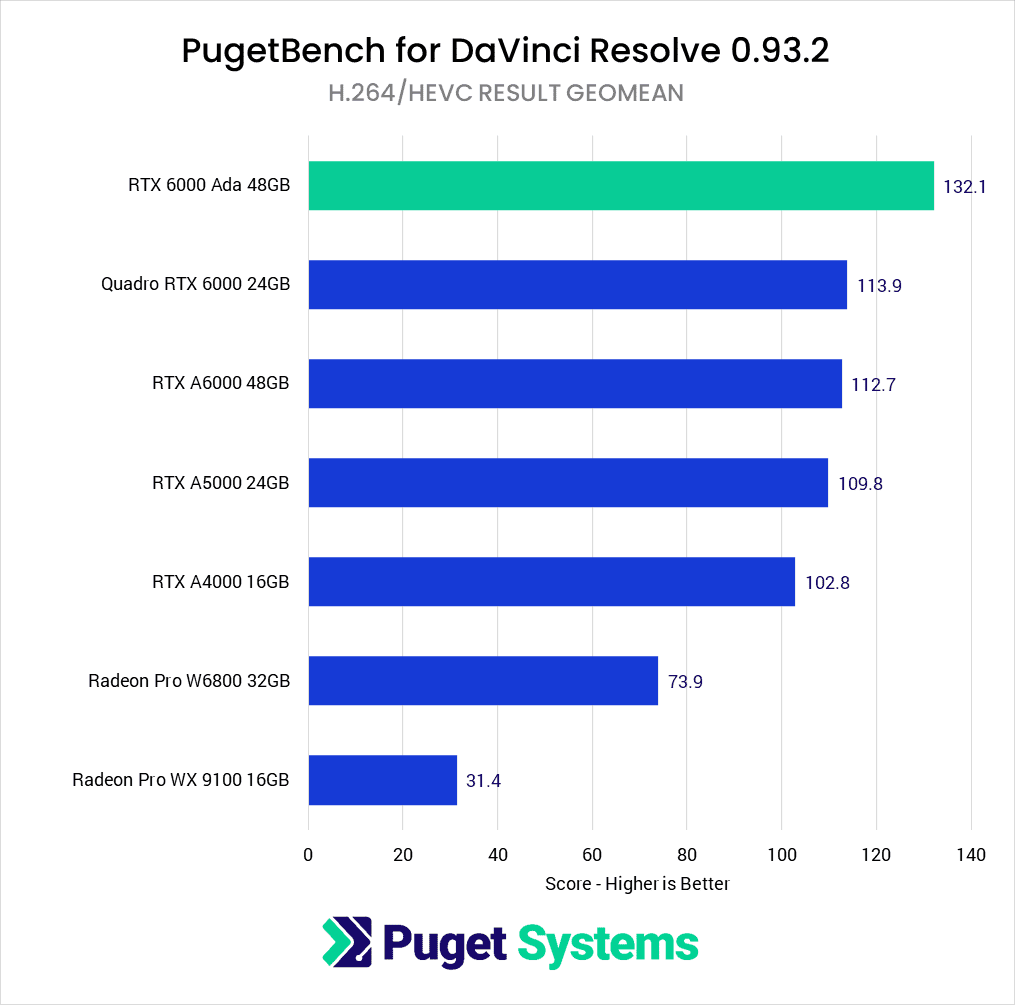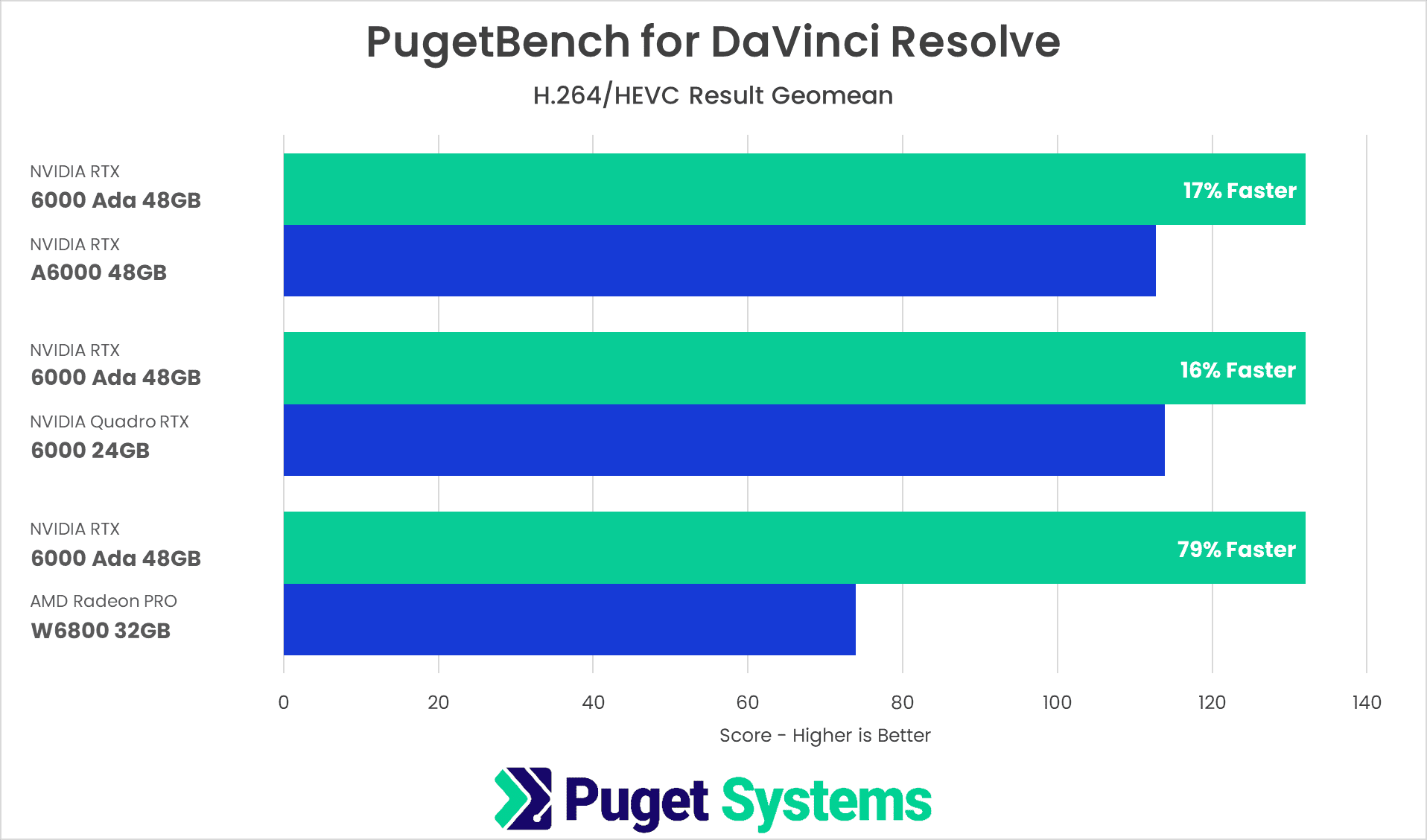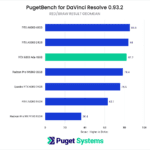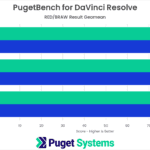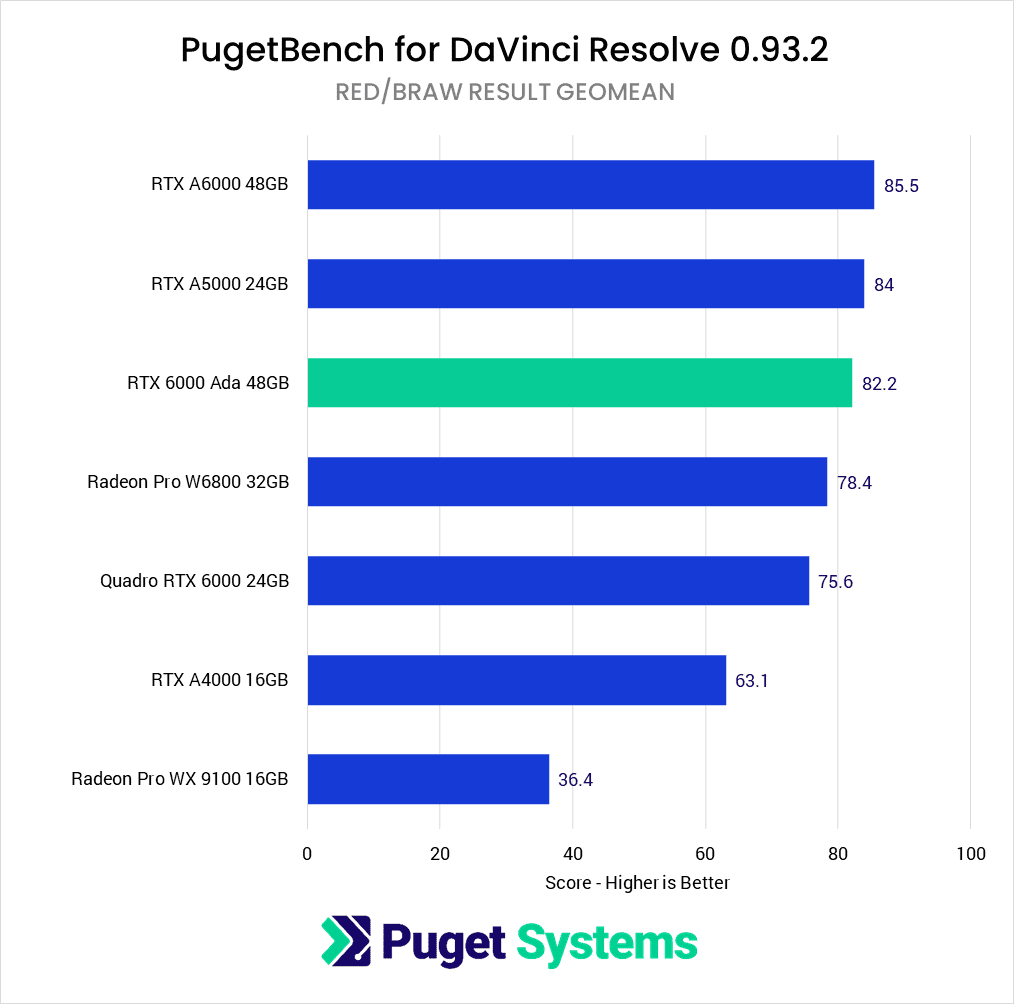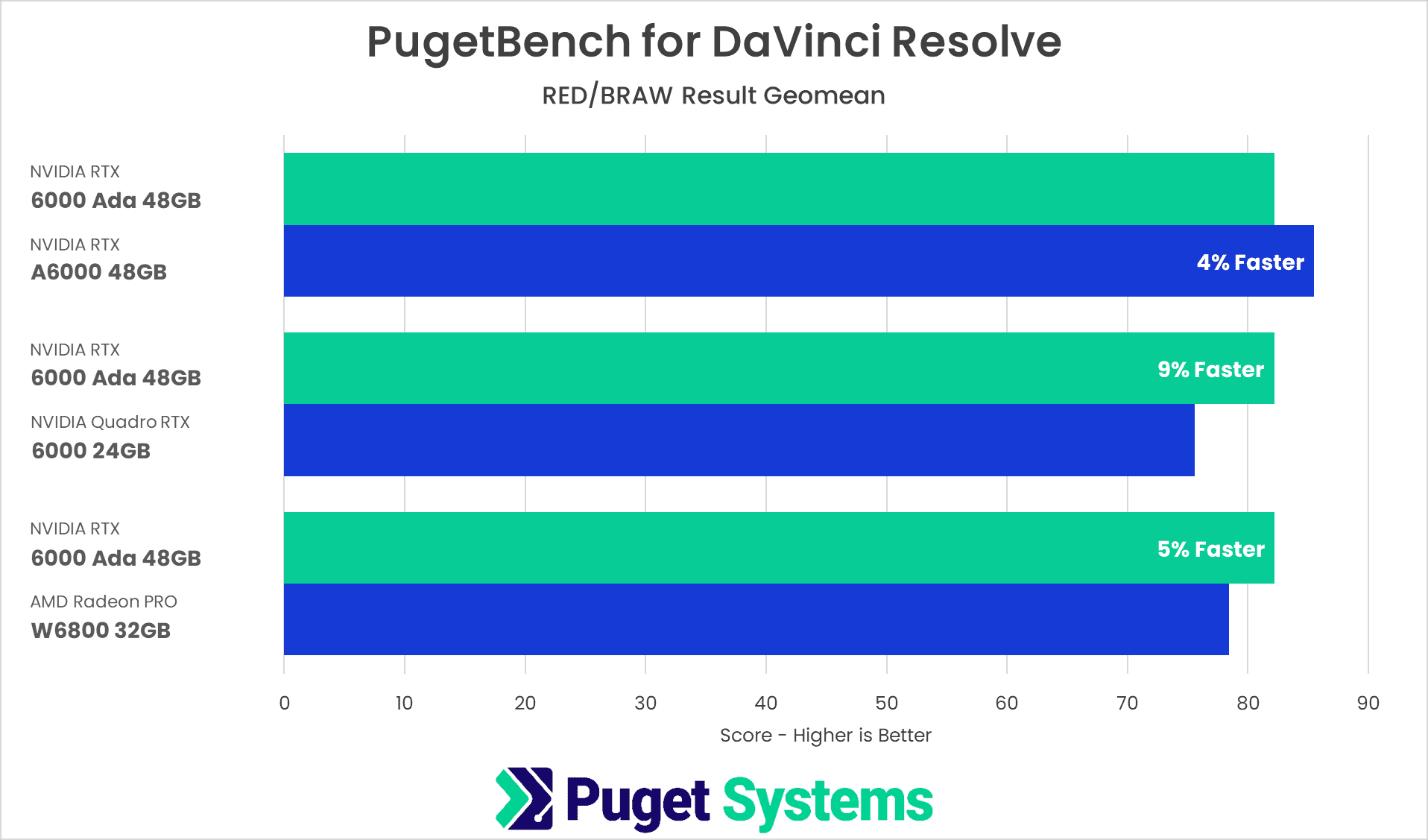Table of Contents
Introduction
NVIDIA has recently launched the first of their “Ada Lovelace” professional GPUs: the RTX 6000 Ada 48GB. While the $6,800 MSRP is going to be steep for many users, the NVIDIA RTX line is very different than the consumer-focused GeForce line in that it is highly focused on reliability and stability above all else. We expect lower-priced models to launch in the future, but we are excited to look at how the RTX 6000 Ada performs in various content creation workflows, as the raw specifications of the card indicate that it should do extremely well.
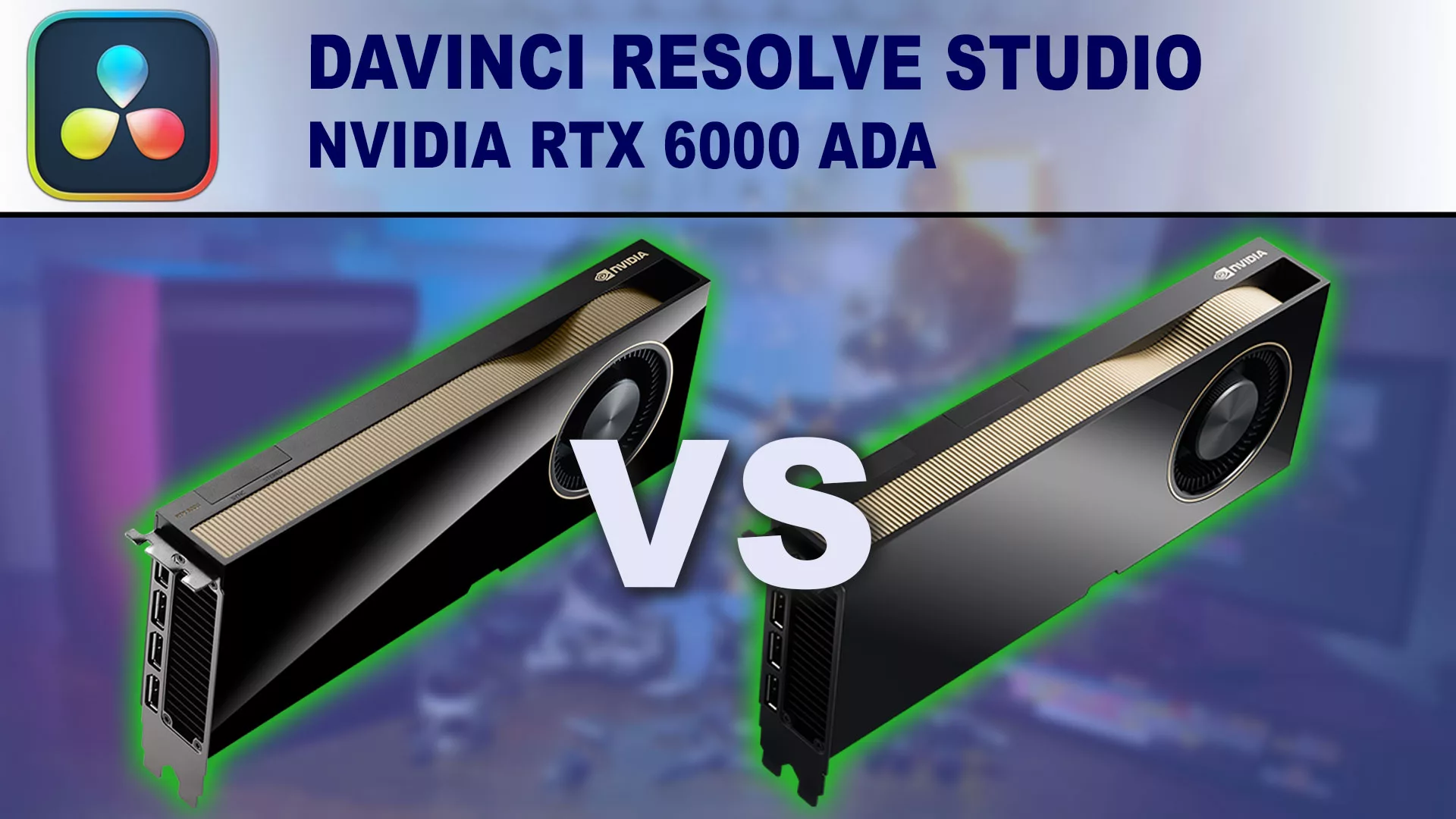
In this article, we will be using our PugetBench for DaVinci Resolve benchmark paired with DaVinci Resolve Studio 18.1.2 to examine the performance of the NVIDIA RTX 6000 Ada for video editing, color grading, and motion graphics. As a comparison, we will include many GPUs from the previous generation (the RTX A6000, A5000, and A4000), as well as the two-generation old Quadro RTX 6000 for additional context. In addition, although AMD does not offer anything near the price of the RTX 6000 Ada, we will also include the top GPU from AMD’s current, and previous generation, Radeon PRO line: the Radeon PRO W6800 and WX 9100.
If you want to read more about the new RTX 6000 Ada, and what sets it apart from the previous generation, we recommend checking out our main NVIDIA RTX 6000 Ada vs RTX A6000 for Content Creation article. That post includes more detailed information on the GPU specifications, testing results for various other applications, and the complete test setup details for the hardware and software used in our testing.
Raw Benchmark Results
While we will be going through our testing in detail in the next section, we always like to provide the raw results for those that want to dig into the details. If there is a specific task you tend to perform in your workflow, examining the raw results will be much more applicable than our more general analysis.
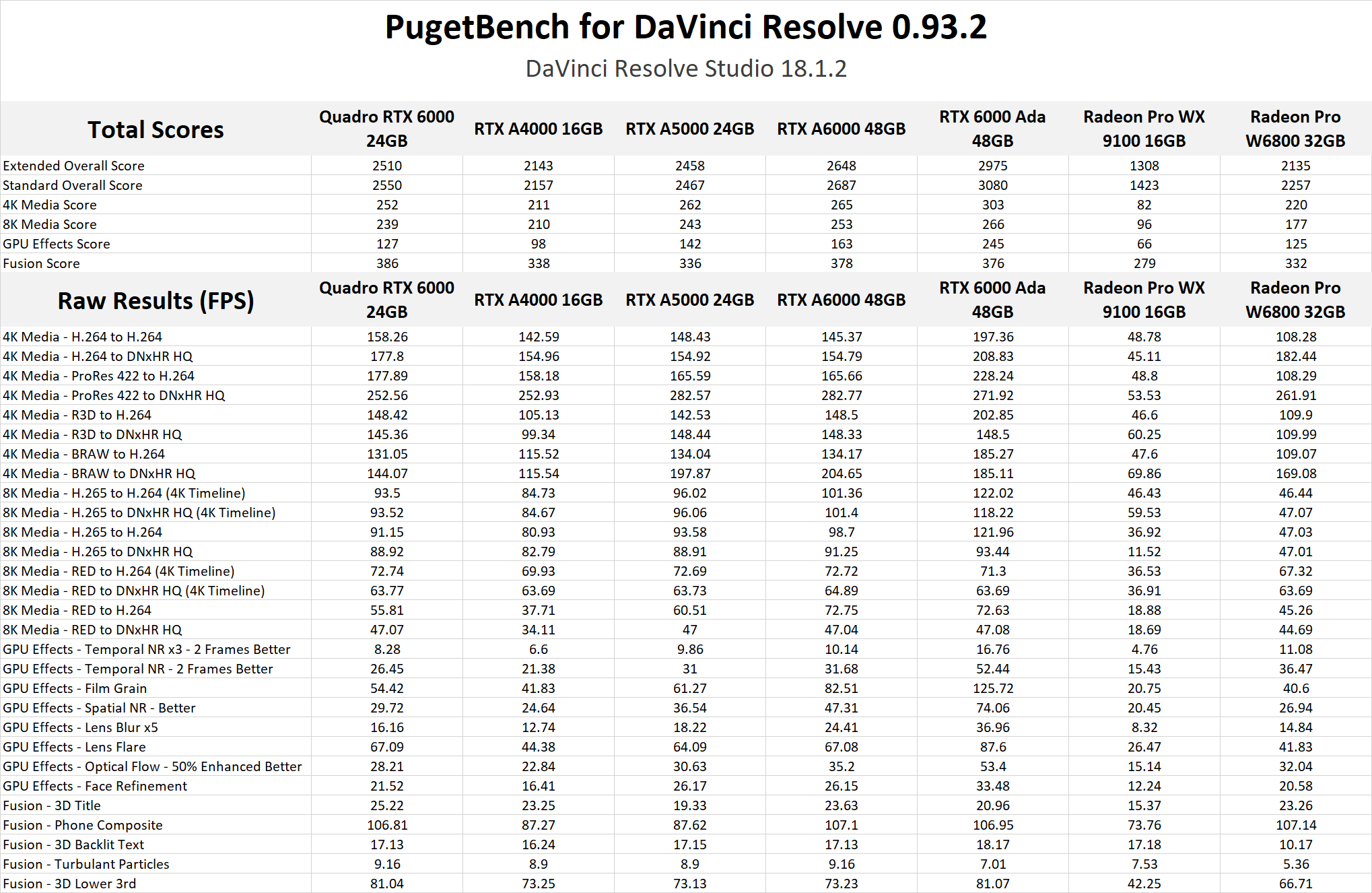
Overall DaVinci Resolve Studio Performance
When it comes to GPU performance in DaVinci Resolve Studio, there are four main areas we typically focus on:
- Overall Score across all tasks
- GPU-accelerated effects performance
- H.264/HEVC decoding/encoding performance
- RAW debayering performance
It is important to note that while most of these results apply to the free version of DaVinci Resolve, the Studio version unlocks many of the GPU effects and adds hardware decoding support for H.264/HEVC media. So, while these results are generally correct for both versions, they are intended primarily for those using the paid Studio version.
Out of the four categories listed above, the Overall Score is likely to be the most relevant single result for most users as it is a combination of various workflows in DaVinci Resolve. It includes several tasks that don’t utilize the GPU much, but that lines up with how most users use DaVinci Resolve day-to-day. However, if you want to take a closer look at how different cards impact performance in more GPU-focused workloads, that is where the other scores come into play that we will look at in the following sections.
With all that said, it is clear from the Overall Score that the new NVIDIA RTX 6000 Ada 48GB is a terrific GPU for DaVinci Resolve. In chart #2, we parsed out the comparisons that most people are likely interested in, and the RTX 6000 Ada came in at a decent 12% faster than the previous generation RTX A6000. That is not a massive performance gain, but keep in mind that this is looking at mixed CPU and GPU workloads, so in the context of this score, it is pretty good.
The performance gain also allows the RTX 6000 Ada to be a healthy 19% faster than the two-generation old Quadro RTX 6000, and nearly 40% faster than the AMD Radeon PRO W6800. It is worth noting that the Radeon PRO W6800 is about 1/3 the cost of the RTX 6000 Ada ($2,250 vs $6,800); however, so this is more of a “top of both product lines” comparison than “performance-per-dollar”. If you wanted to compare NVIDIA and AMD that way, the NVIDIA RTX A5000 is the closest in price, where NVIDIA holds a much smaller 15% performance lead.
While we are looking at just the professional cards from NVIDIA and AMD in this article, we will point out that the tests and overall platform are identical to those in our recent NVIDIA GeForce 40 Series vs AMD Radeon 7000 for Content Creation article. Professional cards are about a LOT more than just raw performance, but the results can be directly comparable between these two articles if you want to compare NVIDIA GeForce and NVIDIA RTX performance. To save you a click, the RTX 6000 Ada is essentially identical to the GeForce RTX 4090 in terms of raw performance in DaVinci Resolve Studio.
GPU Effects Performance
As we mentioned, the Overall Score includes several workloads that do not heavily utilize the GPU. Because of this, we also want to drill down into specific DaVinci Resolve workloads that better utilize a more powerful GPU. First up are GPU-accelerated effects like noise reduction, optical flow, and blurs. These tasks are often GPU bottlenecked, and typically show the largest performance gain you will likely see by using a more powerful GPU.
For these tasks, the new RTX 6000 Ada is really able to show what it can do, coming in at a massive 50% faster than the previous generation RTX A6000. This performance gain makes the RTX 6000 Ada just shy of 2x faster than both the older Quadro RTX 6000, and the modern AMD Radeon PRO W6800.
While we are only testing single-GPU configurations this time, be aware that these tasks also scale very well with multiple GPUs. Generally, you can expect about a 50% performance increase for each additional GPU you use, although there is typically a performance plateau after 3-4 GPUs.
H.264/HEVC Performance
While one of the worst possible types of codecs for editing, H.264 and HEVC are some of the most common codecs in use today, especially in the YouTube/video blog space. Even in professional workflows, they are still often used for stock footage, drone shots, or footage from compact cameras like GoPros. Because of this, being able to work with these codecs efficiently is essential for almost everyone.
We will note that the H.264/HEVC and RAW scores in this, and the next, section, are currently not a part of our public benchmark. This is something we plan on focusing more heavily on in upcoming versions of the benchmark, but for now, we are calculating those scores after the fact by using a geometric mean of the relevant tests.
For this workload, the RTX 6000 Ada does very well, coming in at about 16-17% faster than the previous RTX A6000 and Quadro RTX 6000 GPUs. Interestingly, the last two generations have very similar performance, but this test is usually more about the NVDEC/NVENC decoder/encoder chips on the GPU, rather than raw compute performance.
NVIDIA generally has a very strong lead for GPU decoding/encoding in DaVinci Resolve, and it shows when comparing the RTX 6000 Ada to the AMD Radeon PRO W6800, with the RTX 6000 Ada coming in at a large 80% faster. We will note that in our NVIDIA GeForce RTX 40 Series article, we found that the Radeon 7000 Series showed massive performance gains in this area, so we hope that the next Radeon PRO GPUs from AMD will have much better performance for these types of tasks.
One last thing we will mention is that if this type of codec is something you work with regularly, we would argue that more important than the GPU is to have an Intel Core CPU that supports Quick Sync (as that would be used for H.264/HEVC decoding in place of the GPU). Not only is performance typically a bit better, but it would give you hardware decoding support for a much wider range of HEVC flavors.
RED/BRAW Performance
The last area we wanted to examine in DaVinci Resolve Studio is the performance with RAW codecs like RED and BRAW. This is an area where we are starting to become CPU bottlenecked, however, so there isn’t going to be a massive difference in GPU performance once you get above a mid-range GPU. At the moment, we are doing our testing in the default “debayer” GPU mode, but in the future, we may switch over to “decode+debayer”. We typically like to test applications with default settings, but in this case, Blackmagic seems slow to update their defaults to match the performance capabilities of modern GPUs.
The one thing to point out here is that the new RTX 6000 Ada does show a slight performance relapse compared to the previous generation RTX A6000. This is something we have seen on the consumer GeForce RTX 40 Series cards as well, and appears to be an issue with the new models in general. The difference is small enough that your likely would never notice it in the real world, but it is something we are keeping an eye on.
How Well Does the NVIDIA RTX 6000 Ada Perform in DaVinci Resolve?
Across the board, the NVIDIA RTX 6000 Ada 48GB is a terrific GPU for DaVinci Resolve. While overall performance is only 12% higher than the previous generation RTX A6000 48GB, that includes many workloads that are CPU limited. In GPU-heavy workloads, the 6000 Ada can be up to 50% faster than the previous generation. This large boost also means that depending on the workload, it can be almost 2x faster than the AMD Radeon PRO W6800 32GB, which, while 1/3 the price of the RTX 6000 Ada, is also currently the fastest PRO GPU offering from AMD.
Like any GPU, the exact amount of performance you can expect highly depends on your workflow. As we said, the RTX 6000 Ada excels for GPU-heavy tasks like noise reduction, blurs, and optical flow. Lighter workflows like decoding H.264/HEVC media show a much smaller gain, but the RTX 6000 Ada is still excellent for those workflows. The only area where the RTX 6000 Ada isn’t a significant upgrade over the previous generation is processing RAW footage, although there are settings you can change in Resolve that should allow it to take better advantage of more powerful GPUs like the RTX 6000 Ada.
Overall, the NVIDIA RTX 6000 Ada 48GB is a great choice if it aligns with your needs and budget. The high VRAM can be essential for some workflows, but professional cards like this are primarily intended for high-end workflows where reliability and stability are the top priority. In those cases, the higher cost relative to a consumer GPU is part of an ROI (return on investment) calculation, and depending on the situation, the cost can easily pay for itself if it prevents even a few hours of lost work due to bluescreens or application crashes.
If you are looking for a workstation for DaVinci Resolve Studio with an NVIDIA RTX 6000 Ada 48GB GPU, we recommend checking out our DaVinci Resolve solutions page or contacting one of our technology consultants for help configuring a workstation that meets the specific needs of your unique workflow.

